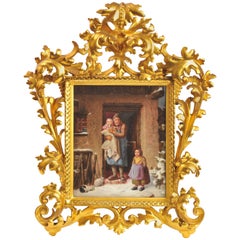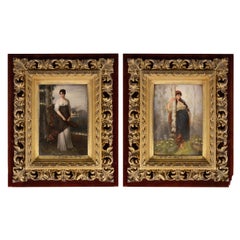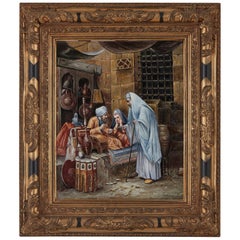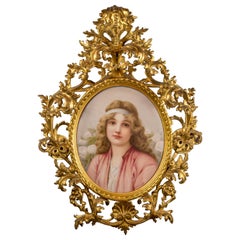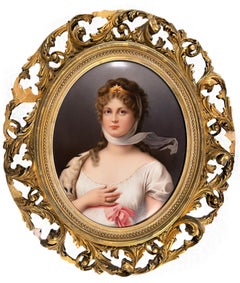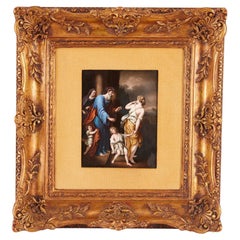Kpm Porcelain Plaque
Antique 1860s European Porcelain
Porcelain
Antique 19th Century Austrian Romantic Porcelain
Porcelain
Antique 19th Century Austrian Porcelain
Porcelain
20th Century German Moorish Paintings
Porcelain, Giltwood
19th Century Figurative Paintings
Porcelain
Antique 19th Century Porcelain
Porcelain
Late 19th Century Portrait Paintings
Porcelain, Wood
Antique 19th Century German Victorian Porcelain
Porcelain, Giltwood
19th Century Figurative Paintings
Porcelain
Early 20th Century German Paintings
Porcelain, Giltwood
19th Century Portrait Paintings
Porcelain
Antique 19th Century German Paintings
Porcelain, Giltwood
19th Century Portrait Paintings
Porcelain
Antique Late 19th Century German Classical Roman Paintings
Giltwood, Porcelain
Antique 19th Century German Decorative Art
Porcelain, Giltwood
Antique 19th Century German Paintings
Porcelain, Giltwood
Antique Late 19th Century Belgian Romantic Paintings
Porcelain, Giltwood
Antique 19th Century German Decorative Art
Porcelain, Giltwood
19th Century Portrait Paintings
Porcelain
19th Century Figurative Paintings
Porcelain, Paint, Glaze
19th Century Victorian More Art
Porcelain
Antique Late 19th Century Rococo Decorative Art
Giltwood, Porcelain
Antique 19th Century German Porcelain
Porcelain, Giltwood
Early 20th Century German Renaissance Paintings
Porcelain
19th Century Victorian More Art
Porcelain
Antique Late 19th Century German Baroque Paintings
Porcelain
Antique Late 19th Century German Porcelain
Porcelain, Giltwood
Antique 19th Century Paintings
Porcelain
19th Century Victorian More Art
Porcelain
Antique Late 19th Century Austrian Paintings
Porcelain
Antique 19th Century German Romantic Porcelain
Porcelain
Antique Late 19th Century German Paintings
Giltwood, Porcelain
Antique Late 19th Century German Paintings
Porcelain, Wood
Early 20th Century German Paintings
Giltwood, Porcelain
Early 20th Century German Classical Greek Paintings
Porcelain, Wood
Antique 19th Century German Renaissance Decorative Art
Porcelain, Giltwood
Antique 1860s German Romantic Paintings
Porcelain
Antique 1850s German Baroque Paintings
Porcelain, Giltwood
Antique Late 19th Century German High Victorian Decorative Art
Porcelain
Mid-19th Century Figurative Paintings
Porcelain, Wood
Antique Late 19th Century German Art Nouveau Ceramics
Porcelain, Gesso
19th Century Portrait Paintings
Porcelain
19th Century Figurative Paintings
Porcelain
Antique 19th Century German Paintings
Porcelain, Giltwood
Antique Late 19th Century German Baroque Revival Paintings
Porcelain
Antique 1890s German Late Victorian Decorative Art
Giltwood, Porcelain
Antique Late 19th Century German Decorative Art
Porcelain
Antique Late 19th Century German Decorative Art
Porcelain
Antique 19th Century German Medieval Paintings
Porcelain
19th Century Figurative Paintings
Porcelain
Antique Late 19th Century German Baroque Paintings
Porcelain, Giltwood
Antique 19th Century German Decorative Art
Porcelain, Giltwood
19th Century Portrait Paintings
Porcelain
19th Century Figurative Paintings
Porcelain
Early 20th Century Other Art Style More Art
Porcelain, Oil
19th Century Victorian More Art
Porcelain
Antique 19th Century German Neoclassical Decorative Art
Porcelain, Giltwood
Antique 19th Century German Picture Frames
Porcelain
- 1
Kpm Porcelain Plaque For Sale on 1stDibs
How Much is a Kpm Porcelain Plaque?
- 1stDibs ExpertSeptember 23, 2024To identify KPM porcelain, first find the maker's marking on your piece. The German manufacturer used different markings over the years, including an eagle, a scepter, an orb on a cross and its KPM initials. Pieces produced after 1925 may also have "Germany" or "Bavaria" accompanying these stamps. By comparing the markings on your piece to images shared on trusted online resources, you can often determine whether it is KPM porcelain and approximately when it was made. Should you have any difficulty, a certified appraiser or knowledgeable antique dealer can be of assistance. On 1stDibs, explore a large selection of KPM porcelain.
- 1stDibs ExpertMarch 15, 2024On porcelain, KPM stands for Königliche Porzellan-Manufaktur, a German maker. The company has been synonymous with exquisite porcelain works fit for nobility and royalty for over 200 years. KPM porcelain plates, centerpieces and sculptures are painstakingly formed through traditional techniques and meticulously painted by hand, producing one-of-a-kind quality. King Frederick II of Prussia founded KPM in Berlin in 1763 after two other entrepreneurs had been unsuccessful in establishing porcelain manufacturing companies in Germany. Shop a collection of Königliche Porzellan-Manufaktur porcelain ware on 1stDibs.
